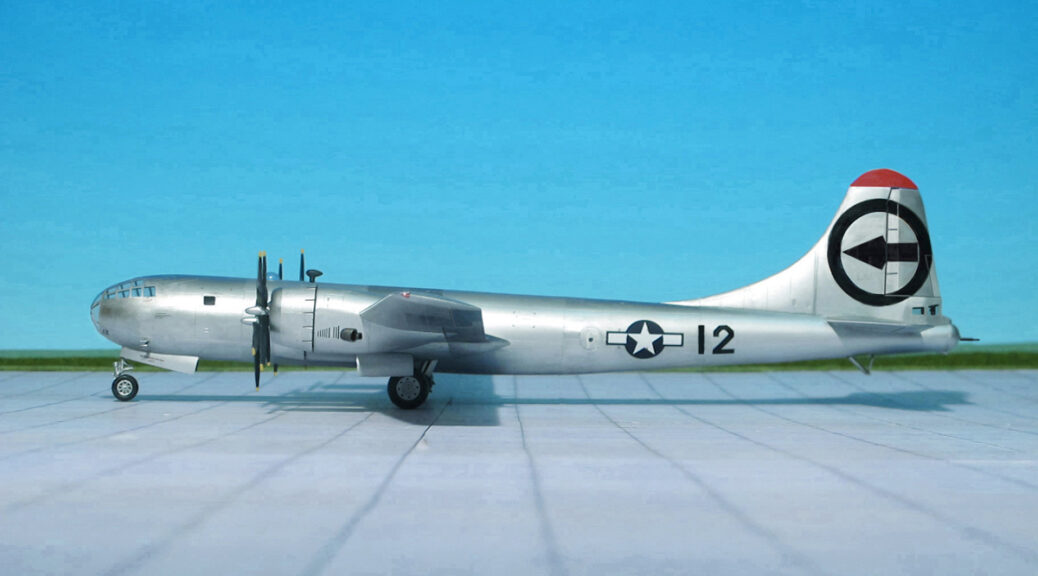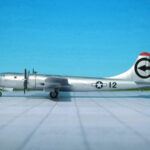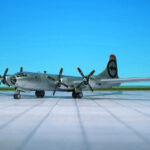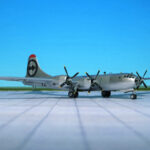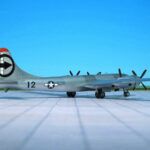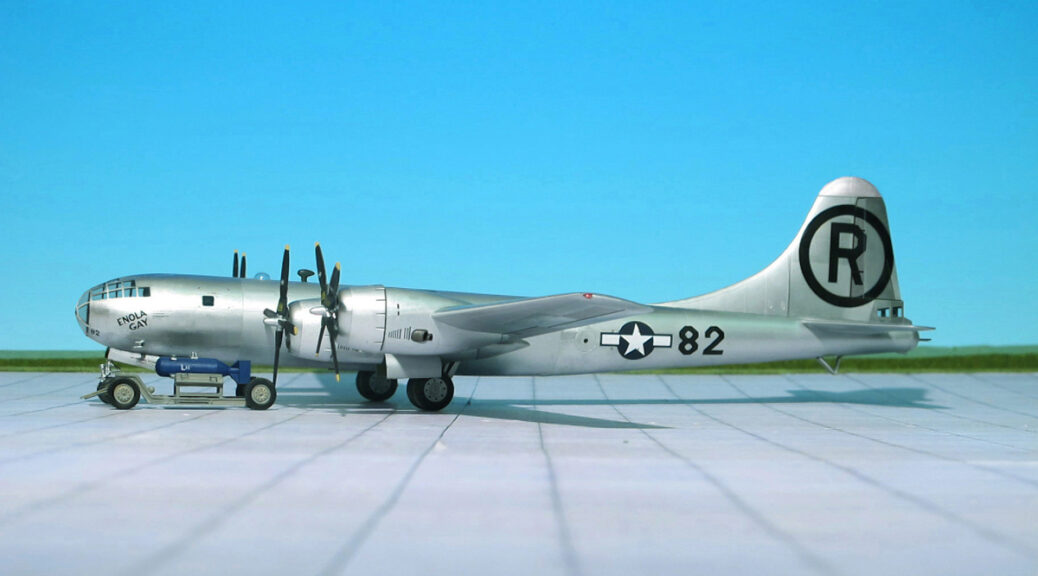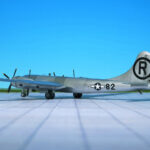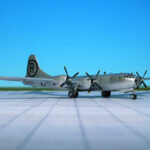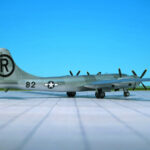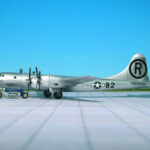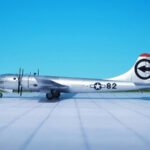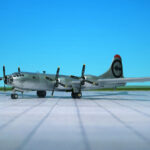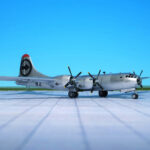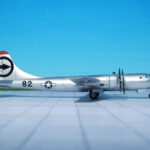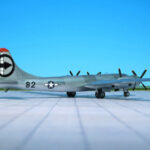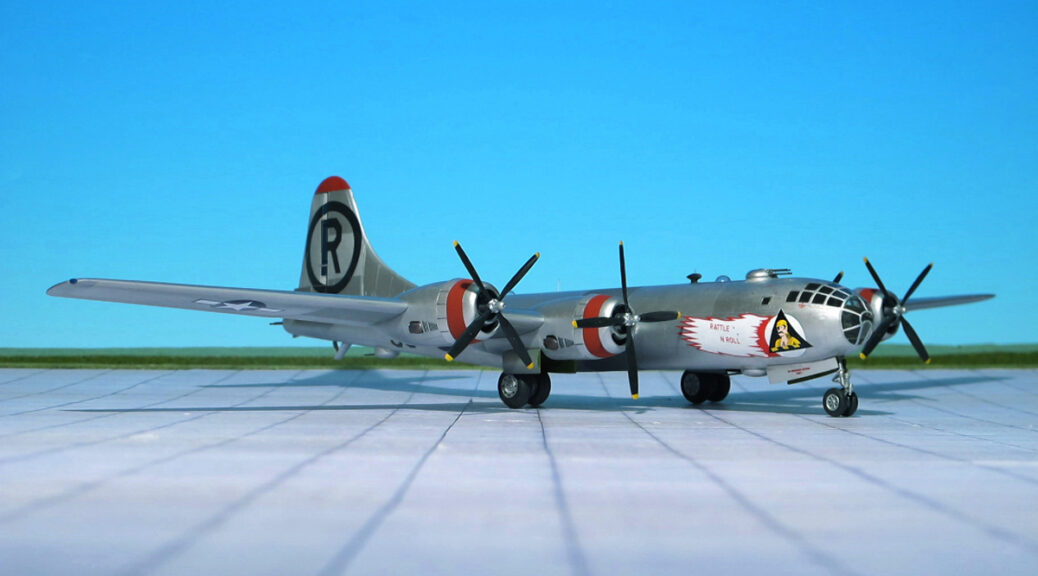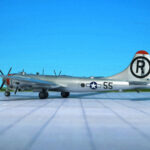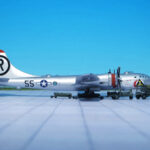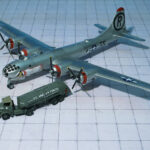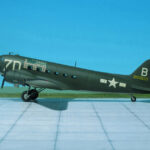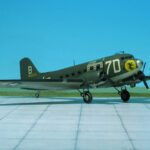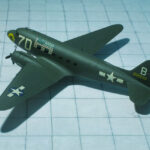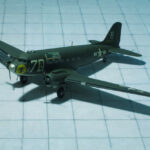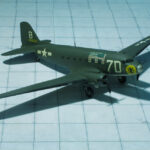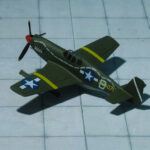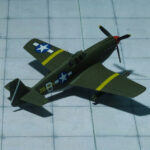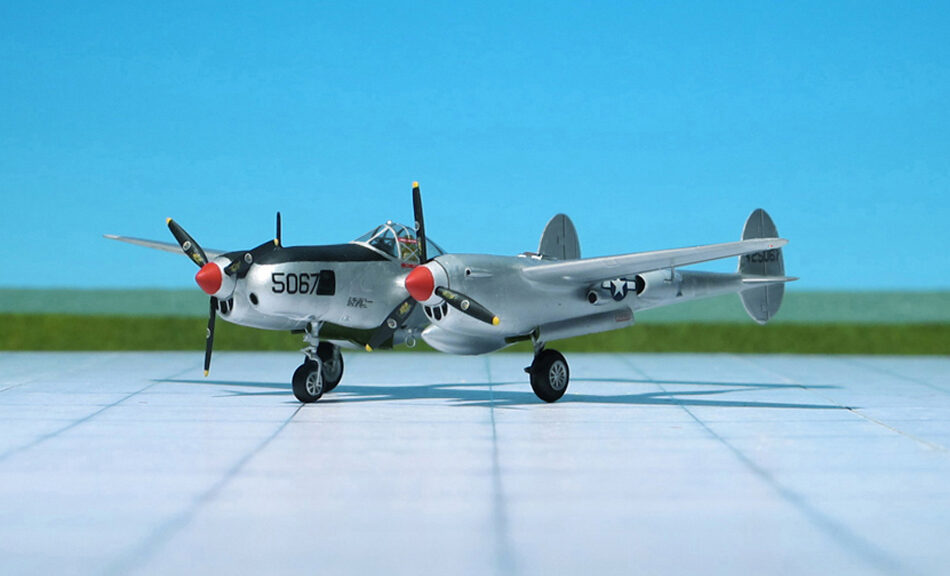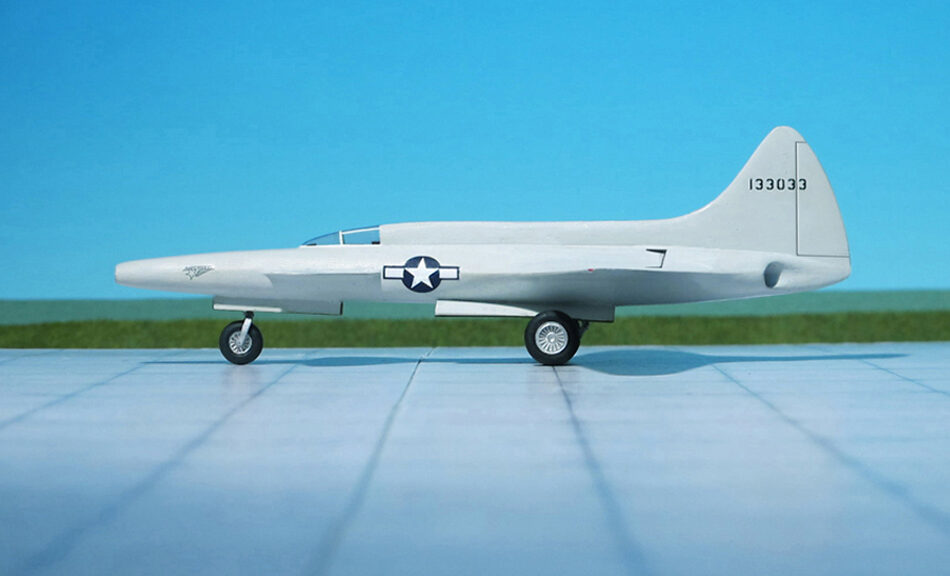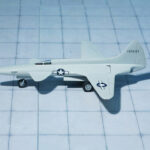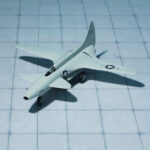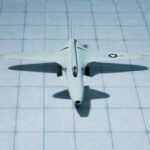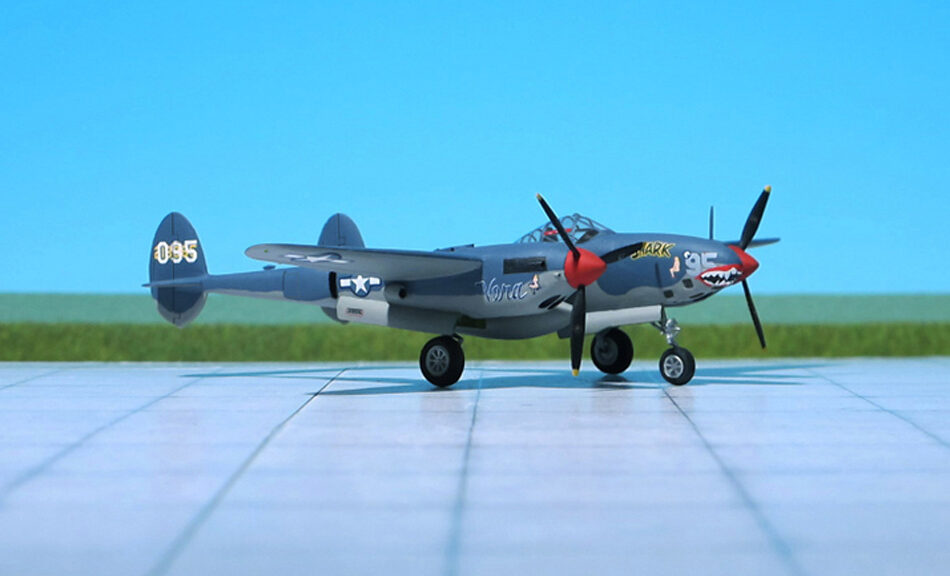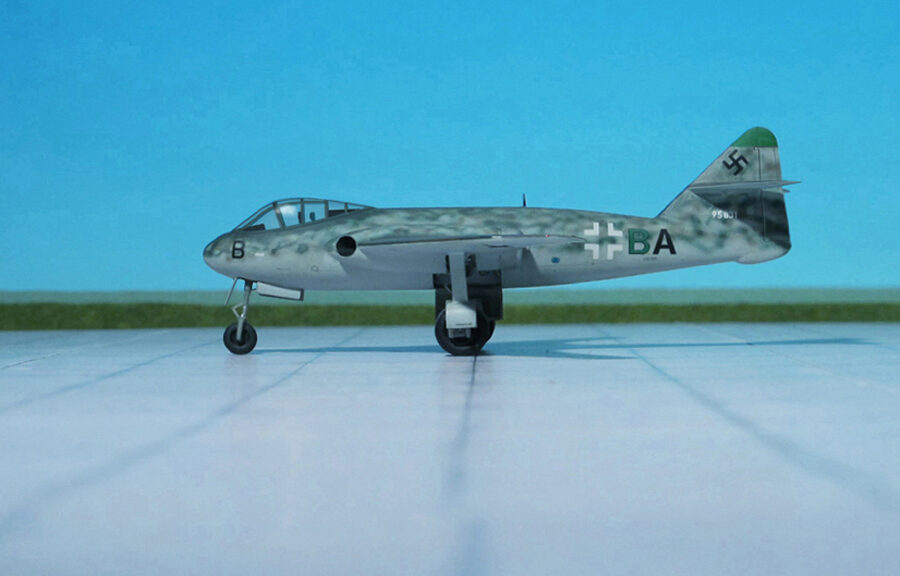COMMENT: The aircraft B-29 Superfortress (Model number B-29-45-MO, Serial number 44-86292, Victor number # 12, (squadron-assigned identification)) – later known as Enola Gay – was built by the Glenn L. Martin Company at its bomber plant in Bellevue, Nebraska. The bomber was one of the first fifteen B-29s built to the “Silverplate” specification— of 65 eventually completed during and after World War II—giving them the primary ability to function as nuclear “weapon delivery” aircraft. These modifications included an extensively modified bomb bay with pneumatic doors and British bomb attachment and release systems, reversible pitch propellers that gave more braking power on landing, improved engines with fuel injection and better cooling, and the removal of protective armor and gun turrets.
The aircraft was personally selected by Colonel Paul W. Tibbets Jr., the commander of the 509th Composite Group, on 9 May 1945, while still on the assembly line. The aircraft was accepted by the United States Army Air Force (USAAF) on 18 May 1945 and assigned to the 393rd Bombardment Squadron, Heavy, 509th Composite Group. The tail marking was a circle outline around an arrowhead pointing forward. The Crew B-9, commanded by Captain Robert A. Lewis, took delivery of the bomber and flew it from Omaha to the 509th base at Wendover Army Air Field, Utah, on 14 June 1945.
Thirteen days later, the aircraft left Wendover for Guam, where it received a bomb-bay modification, and flew to North Field, Tinian, on 6 July. It was initially given the Victor number # 12, but on 1 August, the tail marking of the 509th Composite Group, circle outline around an arrowhead pointing forward, was changed in circle R tail marking of the 6th Bombardment Group, 313th Bomb Wing, as a security measure and had its Victor number changed to # 82 to avoid misidentification with actual 6th Bombardment Group aircraft.
During July, the bomber made eight practice or training flights and flew two missions, on 24 and 26 July, to drop pumpkin bombs on industrial targets at Kobe and Nagoya. Enola Gay was used on 31 July on a rehearsal flight for the actual mission (Ref. 24).
Category Archives: U.S. Army Air Force
U.S.A.
Boeing B-29 Superfortress “Enola Gay”, 393rd BS, Heavy, 509th Composite Group with Atomic Bomb “Little Boy”, Strike on Hiroshima (Post # II)
STRIKE ORDER # 35:
On 5 August 1945, the Strike Order 35 was given to deliver the first atomic bomb Little Boy the next day on 6 August. This order not only gives the detailed time scale of the pre-flight preparations but also the Victor (identifications) number s of all aicraft involved in the attack as well as the names of the aircraft‘s commanding officers. The combat strike consisted of four aircraft with one alternative plane and four weather mission aircraft including one alternative aircraft . Weather Ships had to start at 0200 ET, while the Combat Ships followed one hour later. Victor # 82 was the Enola Gay with Col. Tibbets at the controlls.

ATOMIC BOMB „LITTLE BOY“
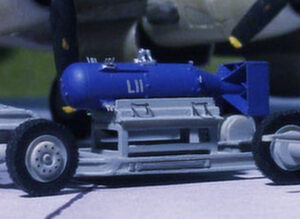
Little Boy was 300 cm in length, 71 cm in diameter and weighed approximately 4,400 kg. The design used the gun method to explosively force a hollow sub-critical mass of enriched uranium and a solid target cylinder together into a super-critical mass, initiating a nuclear chain reaction. This was accomplished by shooting one piece of the uranium onto the other by means of four cylindrical silk bags of cordite powder.
The bomb contained 64 kilograms of enriched uranium. Most was enriched to 89% but some was only 50% uranium-235, for an average enrichment of 80%. Less than a kilogram of uranium underwent nuclear fission, and of this mass only 0.7 grams was transformed into several forms of energy, mostly kinetic energy, but also heat and radiation. The bomb had an explosive force of about 20,000 tons of TNT, about the same as the Fat Man bomb dropped on Nagasaki .
The Little Boy pre-assemblies were designated L-1, L-2, L-3, L-4, L-5, L-6, L-7 and L-11. L-1, L-2, L-5 and L-6 were expended in test drops. L-6 was used in the Iwo Jima dress rehearsal on 29 July. This was repeated on 31 July, but this time L-6 was test dropped near Tinian by Enola Gay. Finally, L-11 was the assembly used for the Hiroshima bomb.
STRIKE ON HIROSHIMA, DATE: AUGUST, 6th, 1945
During preparation for the first atomic mission, Tibbets assumed command of the aircraft and named it after his mother, Enola Gay Tibbets, who, in turn, had been named for the heroine of a novel. In the early morning hours, just prior to the 6 August mission, Tibbets had a young Army Air Forces maintenance man, Private Nelson Miller, paint the name just under the pilot’s window. Except for Enola Gay, none of the 509th Composite Group B-29s had yet had names painted on the noses. All other names were given after the mission.
Hiroshima was the primary target of the first nuclear bombing mission on 6 August, with Kokura and Nagasaki as alternative targets. Enola Gay, piloted by Tibbets, took off from North Field, in the Northern Mariana Islands, about six hours’ flight time from Japan, accompanied by two other B-29s, The Great Artiste, piloted by Major Charles W. Sweeney carrying instrumentation, and a then-nameless aircraft later called Necessary Evil, commanded by Captain George Marquardt, to take photographs
After leaving Tinian, the three aircraft made their way separately to Iwo Jima, where they rendezvoused at 8,010 ft and set course for Japan. The aircraft arrived over the target in clear visibility at 32,333 ft. Navy Captain William S. Parsons of Project Alberta, who was in command of the mission, armed the bomb during the flight to minimize the risks during takeoff. His assistant, Second Lieutenant Morris R. Jeppson, removed the safety devices 30 minutes before reaching the target area.
The release at 08:15 (Hiroshima time) went as planned, and the Little Boy took 53 seconds to fall from the aircraft flying at 31,060 feet to the predetermined detonation height about 1,968 feet above the city. Enola Gay traveled 11.5 mi before it felt the shock waves from the blast. Although buffeted by the shock, neither Enola Gay nor The Great Artiste was damaged.
Enola Gay returned safely to its base on Tinian to great fanfare, touching down at 2:58 pm, after 12 hours 13 minutes. The Great Artiste and Necessary Evil followed at short intervals. Several hundred people, including journalists and photographers, had gathered to watch the planes return. Tibbets was the first to disembark and was presented with the Distinguished Service Cross on the spot (Ref.: 24).
Boeing B-29 Superfortress “Enola Gay”, 393rd BS, Heavy, 509th Composite Group, After the Hiroshima mission (Post # III)
Comment: After the Hiroshima Mission the Enola Gay‘s circle R tail marking of the 6th Bombardment Group, 313th Bomb Wing tail marking was changed to that of the 509th Composite Group, circle outline around an arrowhead pointing forward. The Victor # 82 remained unchanged, Additional First Atomic Bomb Hiroshima – August 6/1945 was painted on starboard side of Enola Gay.
After the war, the Enola Gay returned to the United States, where it was operated from Roswell Army Air Field, New Mexico. In May 1946, it was flown to Kwajalein, Marshall Islands, for the Operation Crossroads nuclear tests in the Pacific, but was not chosen to make the test drop at Bikini Atoll.
Since 2003, the entire restored Boeing B-29 Enola Gay has been on display at National Air and Space Museums’s Steven Udvar-Hazy Center, Chantilly, Fairfax County, Virginia.
Plans for more atomic attacks on Japan
Major General Leslie R. Groves expected to have another Fat Man atomic bomb ready for use on 19 August, with three more in September and a further three in October; a second Little Boy bomb (using U-235) would not be available until December 1945. On 10 August, he sent a memorandum to General of the Army Georg C. Marshall in which he wrote that “the next bomb … should be ready for delivery on the first suitable weather after 17 or 18 August.” Marshall endorsed the memo with the hand-written comment, “It is not to be released over Japan without express authority from the President”, something President Harry S. Truman had requested that day. This modified the previous order that the target cities were to be attacked with atomic bombs “as made ready”. There was already discussion in the War Department about conserving the bombs then in production for Operation Downfall (proposed Allied plan for the invasion of the Japanese home islands near the end of World War II), and Marshall suggested to Secretary of War Henry L. Stimson that the remaining cities on the target list be spared attack with atomic bombs.
Two more Fat Man assemblies were readied, and scheduled to leave Kirtland Field, New Mexico, for Tinian on 11 and 14 August, and Tibbets was ordered by Major General Curtis LeMay to return to Albuquerque, New Mexico, to collect them. At Los Alamos, New Mexico, technicians worked 24 hours straight to cast another plutonium core. Although cast, it still needed to be pressed and coated, which would take until 16 August. Therefore, it could have been ready for use on 19 August. Unable to reach Marshall, Groves ordered on his own authority on 13 August that the core should not be shipped.
On Marshall’s orders, Major General John E. Hull looked into the tactical use of nuclear weapons for the invasion of the Japanese home islands, even after the dropping of two strategic atomic bombs on Japan (Marshall did not think that the Japanese would capitulate immediately). Colonel Lyle E. Seeman reported that at least seven Fat Man-type plutonium implosion bombs would be available by X-Day, which could be dropped on defending forces. Seeman advised that American troops not enter an area hit by a bomb for “at least 48 hours”; the risk of nuclear fallout was not well understood, and such a short time after detonation would have exposed American troops to substantial radiation.
Ken Nicols, the District Engineer of the Manhattan Engineer District, wrote that at the beginning of August 1945, “planning for the invasion of the main Japanese home islands had reached its final stages, and if the landings actually took place, we might supply about fifteen atomic bombs to support the troops.” An air burst 1,800–2,000 ft above the ground had been chosen for the (Hiroshima) bomb to achieve maximum blast effects, and to minimize residual radiation on the ground, as it was hoped that American troops would soon occupy the city (Ref.: 24).
Boeing B-29A Superfortress “Rattle N’ Roll”, 6th Bomber Group, 313th Bomb Wing, XXth USAAF, (Academy Models)
TYPE: High-altitude strategic bomber
ACCOMMODATION: Crew of 11
POWER PLANT: Four Wright R-3350-23 Duplex-Cyclone air-cooled turbocharged radial piston engines, 2,200 hp each
PERFORMANCE: 357 mp
COMMENT: The Boeing B-29 Superfortress was an American four-engined propeller-driven heavy bomber, designed by Boeing and flown primarily by the United States during World War II and the Korean War. Named in allusion to its predecessor, the Boeing B-17 Flying Fortress, the Superfortress was designed for high-altitude strategic bombing, but also excelled in low-altitude night incendiary bombing, and in dropping naval mines to blockade Japan. B-29s dropped the atomic bombs on Hiroshima and Nagasaki, the only aircraft ever to drop nuclear weapons in combat.
One of the largest aircraft of World War II, the B-29 was designed with state-of-the-art technology, which included a pressurized cabin, dual-wheeled tricycle landing gear, and an analog computer-controlled fire-control system that allowed one gunner and a fire-control officer to direct four remote machine gun turrets. The $3 billion cost of design and production, far exceeding the $1.9 billion cost of the Manhattan Project (development oft he atomic bomb), made the B-29 program the most expensive of the war. The B-29 remained in service in various roles throughout the 1950s, being retired in the early 1960s after 3,970 had been built.
Before World War II, the United States Army Air Force (USAAF) concluded that the Boeing B-17 Flying Fortress, which would be the Americans’ primary strategic bomber during the war, would be inadequate for the Pacific Theater, which required a bomber that could carry a larger payload more than 3,000 miles
In response, Boeing began work on pressurized long-range bombers in 1938. Boeing’s design study for the Model 334 was a pressurized derivative of the Boeing B-17 Flying Fortress with nosewheel undercarriage. Although the Air Corps lacked funds to pursue the design, Boeing continued development with its own funds as a private venture. In April 1939, Charles Lindberg convinced General Henry H. Arnold to produce a new bomber in large numbers to counter the Germans’ bomber production. In December 1939, the Air Corps issued a formal specification for a so-called “superbomber” that could deliver 20,000 lb of bombs to a target 2,667 mi away, and at a speed of 400 mph. Boeing’s previous private venture studies formed the starting point for its response to the Air Corps formal specification.
Boeing submitted its Model 345 on May 1940, in competition with designs from Consolidated Aircraft Model 33, which later became the Convair B-32 Dominator, Lockheed XB-30 and Douglas XB-31 Raidmaster. Douglas and Lockheed soon abandoned work on their projects, but Boeing received an order for two flying prototypes, which were given the designation XB-29, and an airframe for static testing on August 1940, with the order being revised to add a third flying aircraft on December. Consolidated continued to work on its Model 33, as it was seen by the Air Corps as a backup if there were problems with Boeing’s design. Boeing received an initial production order for 14 service test aircraft and 250 production bombers in May 1941, this being increased to 500 aircraft in January 1942. The B-29 featured a fuselage design with circular cross-section for strength. The need for pressurization in the cockpit area also led to the B-29 being one of very few American combat aircraft of World War II to have a stepless cockpit design, without a separate windscreen for the pilots.
Manufacturing the B-29 was a complex task that involved four main-assembly factories. Thousands of subcontractors were also involved in the project. The first prototype made its maiden flight on September 1942. The combined effects of the aircraft’s highly advanced design, challenging requirements, immense pressure for production, and hurried development caused setbacks. Unlike the unarmed first prototype, the second was fitted with a Sperry defensive armament system using remote-controlled gun turrets sighted by periscopes and first flew on December 1942, although the flight was terminated due to a serious engine fire.
On February 1943, the second prototype experienced an engine fire and crashed. Changes to the production craft came so often and so fast that, in early 1944, B-29s flew from the production lines directly to modification depots for extensive rebuilds to incorporate the latest changes. USAAF-contracted modification centers and its own air depot system struggled to handle the scope of the requirements. By the end of 1943, although almost 100 aircraft had been delivered, only 15 were airworthy. This prompted an intervention by General Hap Arnold to resolve the problem, with production personnel being sent from the factories to the modification centers to speed availability of sufficient aircraft to equip the first bomb groups in what became known as the “Battle of Kansas”. This resulted in 150 aircraft being modified in the five weeks, between March and April 1944.
The most common cause of maintenance headaches and catastrophic failures was the engines. Although the Wright R-3350 Duplex Cyclone radials later became a trustworthy workhorse in large piston-engined aircraft, early models were beset with dangerous reliability problems.
In wartime, the B-29 was capable of flight at altitudes up to 31,850 feet at speeds of up to 350 mph (true air speed)). This was its best defense because Japanese fighters could barely reach that altitude, and few could catch the B-29 even if they did attain that altitude.
The General Electric Central Fire Control system on the B-29 directed four remotely controlled turrets armed with two .50 Browning M2 machine guns each. All weapons were aimed optically, with targeting computed by analog electrical instrumentation. There were five interconnected sighting stations located in the nose and tail positions and three Plexiglas blisters in the central fuselage. Five General Electric analog computers (one dedicated to each sight) increased the weapons’ accuracy by compensating for factors such as airspeed, lead, gravity, temperature and humidity. The computers also allowed a single gunner to operate two or more turrets (including tail guns) simultaneously. The gunner in the upper position acted as fire control officer, managing the distribution of turrets among the other gunners during combat. The tail position initially had two .50 Browning machine guns and a single M2 20 mm cannon. Later aircraft had the 20 mm cannon removed, sometimes replaced by a third machine gun.
The crew would enjoy, for the first time in a bomber, full-pressurization comfort. This first-ever cabin pressure system for an Allied production bomber was developed for the B-29 by Garrett AiResearck and a long tunnel joining the forward and rear crew compartments. Crews could use the tunnel if necessary to crawl from one pressurized compartment to the other.
In early 1945, Major General Curtiss LeMay, commander of XXI Bomber Command—the Marianas-based B-29-equipped bombing force—ordered most of the defensive armament and remote-controlled sighting equipment removed from the B-29s under his command. The affected aircraft had the same reduced defensive firepower as the nuclear weapons-delivery intended Silverplate B-29 airframes and could carry greater fuel and bomb loads as a result of the change. The lighter defensive armament was made possible by a change in mission from high-altitude, daylight bombing with high explosive bombs to low-altitude night raids using incendiary bombs. As a consequence of that requirement, Bell Atlanta (BA) produced a series of 311 B-29Bs that had turrets and sighting equipment omitted, except for the tail position, which was fitted with AN/APG-15 fire-control radar. That version could also have an improved APQ-7 “Eagle” bombing-through-overcast radar fitted in an airfoil-shaped radome under the fuselage. Most of those aircraft were assigned to the 315th Bomb Wing, Northwest Field, Guam.
In September 1941, the USAAF’ plans for war against Germany and Japan proposed basing the B-29 in Egypt for operations against Germany, as British airbases were likely to be overcrowded. By the end of 1943, plans had changed, partly due to production delays, and the B-29 was dedicated to the Pacific Theater. A new plan implemented deployed the B-29 units to attack Japan from four forward bases in southern Cina, with five main bases in India, and to attack other targets in the region from China and India as needed. The XX Bomber Command, initially intended to be two combat wings of four groups each, was reduced to a single wing of four groups because of the lack of availability of aircraft, automatically limiting the effectiveness of any attacks from China.
This was an extremely costly scheme, as there was no overland connection available between India and China, and all supplies had to be flown over the Himalayas, either by transport aircraft or by B-29s themselves, with some aircraft being stripped of armor and guns and used to deliver fuel.
The solution to this problem was to capture the Mariana Islands, which would bring targets such as Tokyo, about 1,500 mi north of the Marianas within range of B-29 attacks. The Joint Chiefs of Staff agreed in December 1943 to seize the Marianas.
US forces invaded Saipan on 15 June 1944 what was secured by 9 July. Operations followed against Guam and Tinian, with all three islands secured by August.
Naval construction battalions (Seabees) began at once to construct air bases suitable for the B-29, commencing even before the end of ground fighting. In all, five major airfields were built: two on the flat island of Tinian, one on Saipan, and two on Guam. Each was large enough to eventually accommodate a bomb wing consisting of four bomb groups, giving a total of 180 B-29s per airfield. These bases could be supplied by ship and, unlike the bases in China, were not vulnerable to attack by Japanese ground forces. The bases became the launch sites for the large B-29 raids against Japan in the final year of the warand the first combat mission was launched from there on 28 October 1944, with 14 B-29s, the first attack on the Japanese capital since the Doolittle Raid in April 1942.
Boeing B-29A Superfortress “Rattle N’ Roll” showed here belonged to the 6th Bomber Group, 313th Bomb Wing, XXth USAAF, stationed at North Field, Tinian, Marianas
The most famous B-29s were the Silverplate series. These aircraft were extensively modified to carry nuclear weapons. Serious consideration was given to using the British Lancaster bomber, as this would require less modification. The most significant modification was the enlargement of the bomb bay enabling each aircraft to carry either the “Little Boy”, an enriched uranium gun-type fission weapon or “Fat Man”, a plutonium implosion-type nuclear weapon.
Little Boy was dropped on Hiroshima on 6 August 1945 by B-29 Enola Gay, flown by Colonel Paul W. Tibbets Jr and the Fat Man was dropped on Nagasaki on 9 August 1945 by B-29 Bockscar, flown by Mayor Charles W. Sweeney.
Japan surrendered to the Allies on 15 August, six days after the bombing of Nagasaki and effectively ended World War II (Ref.: 24).
Douglas C-47A Skytrain, 80th Troop Carrier Squadron, 436 T.C.G., 9th USAAF, (Italeri Models)
TYPE: Transport, Troop carrier
ACCOMMODATION: Crew of four plus 29 troops
POWER PLANT: Two Pratt & Whitney R-1830-90 Twin Wasp radial engines, rated at 1,200 hp each
PERFORMANCE: 224 mph at 10,000 ft
COMMENT: The Douglas C-47 Skytrain or Dakota (RAF, RAAF, RCAF, RNZAF, and SAAF designation) was a military transport aircraft developed from the civilian Douglas DC-3 airliner. It was used extensively by the Allies during WW II and remained in front-line service with various military operators for many years.
The C-47 differed from the civilian DC-3 by way of numerous modifications, including being fitted with a cargo door, hoist attachment and strengthened floor – along with a shortened tail cone for glider-towing shackles, and an astrodome in the cabin roof.
During World War II, the armed forces of many countries used the C-47 and modified DC-3s for the transport of troops, cargo, and wounded. The U.S. naval designation was Douglas R4D. About 10,174 aircraft were produced in four US factories.
The specialized C-53 Skytrooper troop transport started production in October 1941 at Douglas Aircraft’s Santa Monica plant. It lacked the cargo door, hoist attachment, and reinforced floor of the C-47. Only 380 aircraft were produced in all because the C-47 was found to be more versatile.
The C-47 was vital to the success of many Allied campaigns, in particular, those at Guadalcanal and in the jungles of New Guinea and Burma, where the C-47 and its naval version, the R4D, made it possible for Allied troops to counter the mobility of the light-traveling Japanese Army. Possibly its most influential role in military aviation, however, was flying “The Hump” from India into China. The expertise gained flying “The Hump” was later used in the Berlin Lift, in which the C-47 played a major role until the aircraft were replaced by Douglas C-54 Skymasters.
In Europe, the C-47 and a specialized paratroop variant, the C-53 Skytrooper, were used in vast numbers in the later stages of the war, particularly to tow gliders and drop paratroops. During the invasion of Sicily in July 1943, C-47s dropped 4,381 Allied paratroops. More than 50,000 paratroops were dropped by C-47s during the first few days of the D-Day campaign also known as the Invasion of Normandy, France, in June 1944. In the Pacific War, with careful use of the island landing strips of the Pacific Ocean, C-47s were used for ferrying soldiers serving in the Pacific theater back to the United States.
About 2,000 C-47s (received under Lend-Lease) in British and Commonwealth service took the name „Dakota“, possibly inspired by the acronym “DACoTA” for Douglas Aircraft Company Transport Aircraft.
The C-47 also earned the informal nickname “gooney bird” in the European theatre of operations. Other sources attribute this name to the first aircraft, a USMC R2D—the military version of the DC-2—being the first aircraft to land on Midway Island, previously home to the long-winged albatross known as the gooney bird which was native to Midway
After World War II, thousands of surplus C-47s were converted to civilian airline use, some remaining in operation in 2012, as well as being used as private aircraft (Ref.: 24).
North American A-36A Apache, 86th FBG, 527th FBS (Dive), (Hasegawa Models, Parts scratch-built
TYPE: Ground attack fighter
ACCOMMODATION: Pilot only
POWER PLANT: One Allison V-1710-87 liquid-cooled engine, rated at 1,325 hp
PERFORMANCE: 365 mph
COMMENT: The North American A-36 (listed in some sources as “Apache“ or “Invader”, but generally called Mustang) was the ground-attack/dive bomber version of the North American P-51 Mustang, from which it could be distinguished by the presence of rectangular, slatted dive brakes above and below the wings. A total of 500 A-36 dive bombers served in the Mediterranean and Southeast Asia theaters during WW II before being withdrawn from operational use in 1944.
The A-36 project was a stopgap measure intended to keep North American (NAA) assembly lines running during the first half of 1942 despite the US having exhausted its funds earmarked for fighter aircraft. When the order came for more P-51s in June 1942, the NAA workforce was thoroughly experienced.
With the introduction of the North American Mustang Mk.I with the Roya Air Force’s Army Co-operation Squadrons in February 1942, the new fighter began combat missions as a low-altitude reconnaissance and ground-support aircraft. Supplementing the Curtiss P-40 Tomahawks already in service, Mustang Mk Is were first supplied to No. 26 Squadron RAF, then rapidly deployed to 10 additional squadrons by June 1942.
Despite the limited high-altitude performance of the Allison V-1710 engine, the RAF was enthusiastic about its new mount, which “performed magnificently”. During the Mustang Mk. I’s successful combat initiation, North American’s president pressed the newly redesignated U.S.Army Air Forces (USAAF) for a fighter contract for the essentially similar P-51, 93 of which had passed into the USAAF when the Lend-Lease contract with Britain ran out of funds. The Mustang Mk IA/P-51 used four 20 mm Hispano wing cannon in place of the original armament, a combination of four wing-mounted 7.62 mm M1919 Browning machine guns and four 12.7 mm M2 Browning machine guns, two of which were mounted in the wings, while the second pair was mounted in the “chin”, or lower engine cowling, and synchronized to fire through the propeller. No funds were available for new fighter contracts in fiscal year 1942, but General O. P. Echols and Fighter Project Officer B. S. Kelsey wanted to ensure that the P-51 remained in production.
Since appropriations were available for an attack aircraft, Echols specified modifications to the P-51 to turn it into a dive bomber. The contract for 500 A-36A aircraft fitted with bomb racks, dive brakes, and heavier-duty wing, was signed by Kelsey on 16 April 1942, even before the first flight of the first production P-51 in May 1942. With orders on the books, North American Aviation (NAA) began modifying the P-51 to accept the bomb shackles which had already been tested in a “long-range ferry” program that the RAF had stipulated. Utilizing the basic P-51 airframe and Allison engine, structural reinforcing “beefed up” several high stress areas and “a set of hydraulically operated dive brakes were installed in each main wing plane”. Due to the slightly inboard placement of the bomb racks and unique installation of four cast aluminum dive brakes, a complete redesign of the P-51 wing was required
The first A-36A was rolled out of the NAA Inglewood plant in September 1942, rapidly going through flight testing with the first flight in October, with deliveries commencing soon after of the first production machines. The A-36A continued the use of nose-mounted 12.7 mm machine guns along with wing armament of four 12.7 mm caliber machine guns. The USAAF envisaged that the dive bomber would operate mainly at altitudes below 12,000 ft and specified the use of a sea level-rated Allison V-1710-87, driving a 10 ft 9 in-diameter three bladed Curtiss-Electric propeller and delivering 1,325 hp at 3,000 ft The main air scoop inlet was redesigned to become a fixed unit with a larger opening, replacing the earlier scoop which could be lowered into the airstream. In addition the A-36 carburetor air intake was later fitted with a tropical air filter to stop sand and grit being ingested into the engine.
The USAAF later ordered 310 P-51As, which were essentially A-36s without the dive-brakes and nose-mounted weapons, leaving an armament of four wing-mounted 12.7 mm Browning machine guns. An Allison V-1710-81 1,200 hp was fitted and used the same radiator and air intake as the A-36A. The P-51A was still fitted with bomb racks although it was not intended to be used primarily as a fighter-bomber and the racks were mainly used to carry drop tanks
Besides dive bombing, the A-36A racked up aerial victories, totaling 84 enemy aircraft downed. As fighting intensified in all theaters where the A-36A operated, the dive bomber began to suffer an alarming loss rate with 177 falling to enemy action. The main reason for the attrition was the hazardous missions that placed the A-36A “on the deck” facing murderous ground fire. German defenses in southern Italy included placing cables across hill tops to snare the attacking A-36As. Despite establishing a reputation for reliability and performance, the one “Achilles’ heel” of the A-36A (and the entire Mustang series) remained the ventral-fuselage location of the radiator/cooling system, leading to many of the losses. By June 1944, A-36As in Europe were replaced by Curtiss P-40 Warhawks and Republic P-47 Thunderbolts.
The aircraft model shown here was a North American A-36 Apache of the 86thFBG, 527th FBS showing with only approx. 100 sortie markings in winter 1943/44. In the end the whole side was full of 190 bombing logs, before it was struck off charge. Because it was such a long-lasting aircraft the late-war blue markings were painted over the temporarely red-framed markings anf therefore appear distinctive darker as the blue in the disk (Ref.: 24).
Lockheed F-5E “Lightning”, 7th PRG, 8th USAAF, England, (Matchbox, Parts scratch-built))
TYPE: Photo-reconnaissance aircraft
ACCOMMODATION: Pilot only
POWER PLANT: Two Allison V-1710-111/113 liquid-cooled turbocharged engines, rated at 1,600 hp each
PERFORMANCE: 414 mph at 25,000 ft
COMMENT: The Lockheed P-38 Lightning was an American single-seat, piston-engined fighter aircraft that was used during World War II. Developed for the United States Army Air Corps, the P-38 had distinctive twin booms and a central nacell containing the cockpit and armament. Along with its use as a general fighter, the P-38 was utilized in various aerial combat roles including as a highly effective fighter-bomber, a night-fighter and as a long-range escort fighter when equipped with drop tanks. The P-38 was also used as a bomber-pathfinder, guiding streams of medium and heavy bombers; or even other P-38s, equipped with bombs, to their targets. Used in the aerial reconnaissance role, the P-38 accounted for 90 percent of the aerial film captured over Europe.
The first combat-capable Lightning was the P-38E which rolled out of the factory in October 1941. Because of the versatility, redundant engines, and especially high speed and high altitude characteristics of the aircraft, as with later variants over a hundred P-38Es were completed in the factory or converted in the field to a photoreconnaissance variant, the F-4, in which the guns were replaced by four cameras. Most of these early reconnaissance Lightnings were retained stateside for training, but the F-4 was the first Lightning to be used in action in April 1942. In total 99 P-38E were converted to F-4.
After 210 P-38Es were built, they were followed, starting in February 1942, by the Lockheed P-38F. Its photo reconnaissance version was the Lockheed F-4A Lightning of which 90 aircraft were built.
The Lockheed P-38F was followed in June 1942 by the P-38G, using more powerful Allisons of 1,400 hp each and equipped with a better radio. The reconnaissance variant was the F-5A, 181 aircraft were built.
The following 323 reconnaissance versions F-5B and F-5C were converted from Lightning P-38J. Major differences were the introduction of uprated Allison engines as well as a new the turbosupercharger intercooler system.
The P-38L Lightning was the most numerous variant of the Lightning, with 3,923 built. It entered service with the USAAF in June 1944, in time to support the Allied invasion of France on D-Day. The F-5E reconnaissance variants were converted from the P-38J and P-38L. In total 705 aircraft had been converted for photographic reconnaisssance duties. The aircraft shown here probably belongs tot he 7th Photographic Reconnaisance Group (PRG), 8th USAAF, stationed at Chalgrove, England (Ref.: 24).
Lockheed L-133 Starjet (Sharkit Models, Resin)
TYPE: Fighter aircraft
ACCOMMODATION: Pilot only
POWER PLANT: Two Lockheed L-1000 axial-flow turbojets 2,345 kp thrust each
PERFORMANCE: 625 mph
COMMENT: The Lockheed L-133 was an exotic design started in 1939 which was proposed to be the first jet fighter of the United States Army Air Forces (USAAF) during World War II.
The radical design was to be powered by two axial-flow turbojets with an unusual blended wing-body canard design capable of 612 mph in level flight. The USAAF rejected the 1942 proposal, but the effort speeded the development of the USAAF’s first successful operational jet fighter, the Lockheed P-80 Shooting Star, which did see limited service near the end of war. The P-80 was a less radical design with a single British-based Allison J33 engine, with a conventional tail, but it retained a wing which was the same shape as the outer wing sections of the Lockheed P-38 Lightning.
The Lockheed aviation company was the first in the United States to start work on a turbojet-powered aircraft, the L-133 design started in 1939 as a number of “Paper Projects” by engineers around Clarence L. „Kelly“ Johnson. By 1940 preliminary work on a company-financed turbojet-fighter had been started, which progressed to several different versions on the drawing board. In the meantime, Lockheed was working on an axial-flow L-1000 turbojet engine of their own design, which was intended to power the culmination of the twin-engine jet fighter project, the Model L-133-02-01.
Throughout World War II, the development of a jet-powered fighter had the potential to bring a decisive advantage in the air battles of the war; as history played out, only Germany built significant numbers of jet fighters before the war ended, but they reached service in the Luftwaffe too late to make a difference.
On March 30, 1942, Lockheed formally submitted the L-133-02-01 to the USAAF for consideration. Powered by two L-1000 turbojets and featuring a futuristic-appearing canard design with slotted flaps to enhance lift, the single-seat fighter was expected to have a top speed of 612 mph in level flight, but a range of only 310 mi.
The L-133 had a main wing shape that was essentially identical to the outer wing sections of the Lockheed P-38 Lightning. In many respects the L-133 was far ahead of its time, with futuristic features including: canard layout, blended wing-body planform, and two engines in a very low-drag integral fuselage location.
The USAAF considered the L-133 to be too advanced for the time, and did not pursue the project. The experience gained with the design served Lockheed well in the development of the USAAF’s first operational jet fighter, the P-80 Shooting Star. Although entering combat service after the war had ended, the P-80 was less advanced than the L-133. Because the USAAF didn’t give the L-133 project the go-ahead, the advanced engines intended for the L-133 had long pauses in their development. The most expedient engine choice for the P-80 thus became the Allison J33, based on British centrifugal compressor designs. The P-80 was a cheap-to-build single-engine aircraft with a conventional wing and tailplane design, not using the blended wing-body and canard layout of the L-133 (Ref.:24).
Lockheed F-4A “Lightning”, 12th PRG, ( RS Models)
TYPE: Photo-reconnaissance aircraft
ACCOMMODATION: Pilot only
POWER PLANT: Two Allison V-1710-49/53 liquid-cooled engines, rated at 1,225 hp each
PERFORMANCE: 351 mph at 10,000 ft
COMMENT: The Lockheed P-38 Lightning was an American single-seat, piston-engined fighter aircraft that was used during World War II. Developed for the United States Army Air Corps, the P-38 had distinctive twin booms and a central nacell containing the cockpit and armament. Along with its use as a general fighter, the P-38 was utilized in various aerial combat roles including as a highly effective fighter-bomber, a night-fighter and as a long-range escort fighter when equipped with drop tanks. The P-38 was also used as a bomber-pathfinder, guiding streams of medium and heavy bombers; or even other P-38s, equipped with bombs, to their targets. Used in the aerial reconnaissance role, the P-38 accounted for 90 percent of the aerial film captured over Europe.
Delivered and accepted Lightning production variants began with the P-38D model. The few “hand made” YP-38s initially contracted were used as trainers and test aircraft. There were no Bs or Cs delivered to the government as the USAAF allocated the ‘D’ suffix to all aircraft with self-sealing fuel tanks and armor. Many secondary but still initial teething tests were conducted using the earliest D variants.
The first combat-capable Lightning was the P-38E Lightning and its photo-recon variant the F-4, which featured improved instruments, electrical, and hydraulic systems. Part-way through production, the older Hamilton Standard Hydromatic hollow steel propellers were replaced by new Curiss Electric duraluminium propellers.
The first P-38E rolled out of the factory in October 1941and promptly filled the news wires of the world. Because of the versatility, redundant engines, and especially high speed and high altitude characteristics of the aircraft, as with later variants over a hundred P-38Es were completed in the factory.
After 210 P-38Es were built, they were followed, starting in February 1942, by the Lockheed P-38F, which incorporated racks inboard of the engines for fuel tanks or a total of 910 kg of bombs. Early variants did not enjoy a high reputation for maneuverability, though they could be agile at low altitudes if flown by a capable pilot, using the P-38’s forgiving stall characteristics to their best advantage. From the P-38F-15 model onwards, a “combat maneuver” setting was added to the P-38’s Fowler flaps which allowed the P-38 to out-turn many contemporary single-engined fighters at the cost of some added drag. However, early variants were hampered by high aileron control forces and a low initial rate of roll, and all such features required a pilot to gain experience with the aircraft, which in part was an additional reason Lockheed sent its representative to England, and later to the Pacific Theater.
In March 1942 the first deliveries of the photoreconnaissance version Lockheed F-4 were made. Otherwise similar to the P-38E from which it was converted, the F-4 had the nose armament supplanted by four K-17 cameras for reconnaissance duties. A drift sight and auto pilot were standart in the photographic Lightnings, which were painted in cerulean blue. More than 100 F-4 reconnaissance aircraft based on the P-38E and 20 F-4A based on the P-38F were built.
The aircraft shown here belonged to the 12th Photo Reconnaissance Group, 15th Air Force, Mediterranean Theater (Ref.: 24).
Messerschmitt Me P.1101/28 (Resin, Frank Modellbau)
TYPE: Fast bomber and destroyer
ACCOMMODATION: Crew of two (Pilot and radiooperator/navigator)
POWER PLANT: Two Heinkel-Hirth HeS 011 turbojet engines, rated at 1.300 kp thrust each
PERFORMANCE: 565 mph
COMMENT: This project study of 11. April 1945 (Little note: less than four weeks before the total collaps of the “Third Reich”!!!!) for a two seat “Schnellbomber” (fast bomber) and “Zerstörer” (destroyer) constituted a further development of the Messerschmitt Me P.1099, Me P.1100 and Me P.1101 series of proposals of 1944 on the basis of the original in service Messerschmitt Me 262.
Whereas the basic fuselage, spacious cockpit and tail surfaces of the mentioned follow-up proposals were retained, the two Heinkel-Hirth HeS 011 turbojets were relocated into the wing root to which the new wings having a leading edge sweep of almost 40 degrees were attached. An interesting feature of the design was that the mainwheels were to retract inwards to rest vertically in the fuselage between the fore and aft fuel tanks. Exactly how this was to be accomplished with the turbojets in the way is not clear from the documents. Although the final form of the fuselage nose portion had not been decided, the end of the war brought an early end of the project (Ref.: 16).
